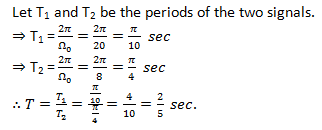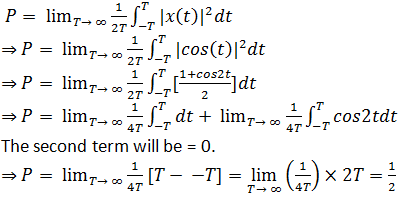This set of Signals & Systems Questions and Answers for Freshers focuses on “Signal Classification and Properties – 2”.
1. A signal is a physical quantity which does not vary with ____________
a) Time
b) Space
c) Independent Variables
d) Dependent Variables
View Answer
Explanation: A signal is a physical quantity which varies with time, space or any other independent variables. Therefore, it does not vary with dependent variables.
2. Most of the signals found in nature are _________
a) Continuous-time and discrete-time
b) Continuous-time and digital
c) Digital and Analog
d) Analog and Continuous-time
View Answer
Explanation: Signals naturally are continuous-time signals. These are also known as analog signals. Continuous-time or analog signals are defined for all values of time t.
3. Which one of the following is not a characteristic of a deterministic signal?
a) Exhibits no uncertainty
b) Instantaneous value can be accurately predicted
c) Exhibits uncertainty
d) Can be represented by a mathematical equation
View Answer
Explanation: Deterministic signal is one which exhibits no uncertainty and its instantaneous value can be accurately predicted from its mathematical equation. Therefore, a deterministic signal doesn’t exhibit uncertainty. However, a random is always uncertain.
4. Determine the fundamental period of the following signal:sin60t.
a) 1/60 sec
b) 1/30 sec
c) 1/20 sec
d) 1/10 sec
View Answer
Explanation: Consider the equation: sinΩ0t. Comparing this equation with the one given in the question: sin60t
⇒ Ω0=60π
5. Sum of two periodic signals is a periodic signal when the ratio of their time periods is ____________
a) A rational number
b) An irrational number
c) A complex number
d) An integer
View Answer
Explanation: Sum of two periodic signals is a periodic signal only when the ratio of their time periods is a rational number or it is the ratio of two integers. For e.g., T1/T2 = 5/7 → Periodic; T1/T2 = 5 → Aperiodic.
6. Determine the Time period of: x(t)=3 cos(20t+5)+sin(8t-3).
a) 1/10 sec
b) 1/20 sec
c) 2/5 sec
d) 2/4 sec
View Answer
7. What is the even component of a discrete-time signal?
a) xe (t) = \(\frac{1}{2}\)[x(t) + x(-t)]
b) xe (n) = \(\frac{1}{2}\)[x(n) + x(-n)]
c) xe (t) = \(\frac{1}{2}\)[x(t) – x(-t)]
d) xe (n) = \(\frac{1}{2}\)[x(n) – x(-n)]
View Answer
8. Determine the odd component of the signal: x(t)=cost+sint.
a) sint
b) 2sint
c) cost
d) 2cost
View Answer
9. Is the signal sin(t) anti-symmetric?
a) YES
b) NO
View Answer
Explanation: A signal is said to be anti-symmetric or odd signal when it satisfies the following condition:
⇒ x(t) = – x(t)
Now, here, x(t) = sin(t) ⇒ x(-t) = sin(-t) = – sin(t)
∴ Sin(t) is an anti-symmetric signal or an odd signal.
10. For an energy signal __________
a) E=0
b) P= ∞
c) E= ∞
d) P=0
View Answer
Explanation: A signal is called an energy signal if the energy satisfies 0<E< ∞ and power P=0.
11. Determine the power of the signal: x(t) = cos(t).
a) 1/2
b) 1
c) 3/2
d) 2
View Answer
12. Is the following signal an energy signal?
x(t) = u(t) – u(t – 1)
a) YES
b) NO
View Answer
13. A signal is anti-causal if ______________
a) x(t) = 0 for t = 0
b) x(t) = 1 for t < 0
c) x(t) = 1 for t > 0
d) x(t) = 0 for t > 0
View Answer
Explanation: A signal is said to be anti-causal when x(t) = 0 for t > 0.
14. Is the signal x(t)= eat u(t) causal?
a) YES
b) NO
View Answer
Explanation: A signal is said to be causal if it is 0 for t < 0.
Now, we know, u(t) = 1 for t ≥ 0.
∴ x(t)= eat for t ≥0 .
∴ The signal is 0 for t < 0.
∴ The signal is causal.
15. Is the signal x(n) = u(n + 4) – u(n – 4) causal?
a) YES
b) NO
View Answer
Explanation: A signal is said to be causal if it is 0 for t < 0.
⇒ u (n + 4) = 1 for n ≥ – 4
⇒ u(n – 4) = 1 for n ≥ 4
∴ The signal x (t) is defined for the interval [-4, 4] and it is zero for all other n values.
∵ The signal is defined for both n > 0 and n < 0
∴ The signal is non-causal.
Sanfoundry Global Education & Learning Series – Signals & Systems.
To practice all areas of Signals & Systems for Freshers, here is complete set of 1000+ Multiple Choice Questions and Answers.
If you find a mistake in question / option / answer, kindly take a screenshot and email to [email protected]





